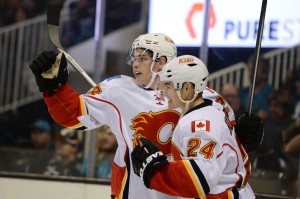Way, way back in 2004, the Calgary Flames opened a lot of eyes and leaped forward in their organization’s development. Aided by a rag-tag group of seemingly mis-matched players playing a very specific style of hockey, the Flames beat three division-winning clubs en route to a berth in the Stanley Cup Final. It was one of the most fascinating teams and stories in recent National Hockey League history.

On Saturday, the 2015 edition of the Flames continued to write their story, defeating the Vancouver Canucks in a thrilling 7-4 comeback and eliminating the Canucks from the post-season.
Yes, just like they did in 2004.
Outside of the Flames’ series of improbable comebacks against teams supposedly better than them, this year’s edition of the club has many other similarities to the 2004 vintage.
First and foremost, both Flames are helmed by a veteran coach with a strong reputation who commands complete “buy in” from his club. The 2004 edition was led by Darryl Sutter, who established a hard-nosed reputation as a player and brought such a style to every team he coached. The 2015 edition is helmed by Bob Hartley, a former Stanley Cup champion who never played at a high level, but brings a attention to detail that he demands from his players.
Much like the 2004 club, the 2015 edition of the Flames relies on a physical game seemingly designed to maximize the team’s effectiveness under the rules of the day. The 2004 Flames played a bruising, grinding game. They clutched and grabbed. They attempted to wear down a team with physical exertion and occasional fist-fights, and basically tried to slow the game down to a crawl and grind out wins. The 2015 Flames instead play a game seemingly designed to push the pace for as long as needed to tire out their opposition. However, the playoff version of this style involves a great deal of physicality, particularly on the forecheck, designed to separate the puck-carrier from the puck and create chances off the transition rushes.
The 2004 Calgary Flames were defined by the success of their unlikely, unsung heroes. Among them?
- Polish enforcer Krzysztof Oliwa scored two goals – he had three over the entire regular season.
- Grinders Shean Donovan, Marcus Nilson and Ville Nieminen were the team’s backbone.
- Veteran pivot Stephane Yelle was a stalwart of the penalty kill and was equally likely to throw his body in front of a shot as he was to win a key late-game face-off.
- And who can forget bottom-pairing defender Steve Montador, who scored a game-winning goal in the Western Conference Final and formed a cult-popular pairing with fellow depth player Mike Commodore.
So far, the 2015 Flames have also seen some unlikely heroes, including 18-year-old Sam Bennett and bruising rookie Michael Ferland. Notably, Deryk Engelland fought two Vancouver Canucks in Game 2, and veteran center Matt Stajan – best known for coming over to Calgary in the Dion Phaneuf trade – scored the series-clinching goal to eliminate the Canucks.
The Stajan goal capped Calgary’s comeback from 3-0 and 4-3 deficits in the series’ sixth and deciding game.
The primary difference between the 2004 and 2015 teams is a key one. In 2004, Calgary was a team that played a very specific brand of hockey and was held together by its tightly-knit team, as is the 2015 team. But the 2004 team had Jarome Iginla and Miikka Kiprusoff at the fore, functionally dragging their club to the promised land. The 2015 has several veterans in key supporting roles, but the key pieces of this year’s club are young – Johnny Gaudreau is 21, Sean Monahan is 20, and T.J. Brodie is 24. Granted, they are nicely complemented by key veterans like Jiri Hudler and Dennis Wideman, but the drivers of this bus are mostly young players.
The 2004 team failed to win a Stanley Cup because their playing system was very physically taxing, and the team basically ran out of functional human bodies to plug into it, and they ran out of gas in the Stanley Cup Final. The 2015 team plays a similarly physically taxing system, reliant on maintaining speed, discipline and blocking a ton of shots. That last part is why this team will likely fade over the course of the playoffs.
However, given how the team’s key pieces are quite young and still developing, there’s a pretty good chance that this won’t be the last we hear of them in the post-season mix over the next few years.
